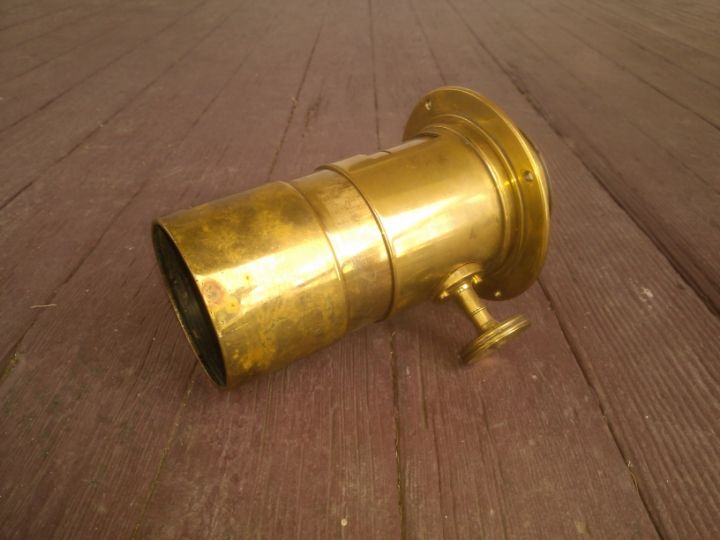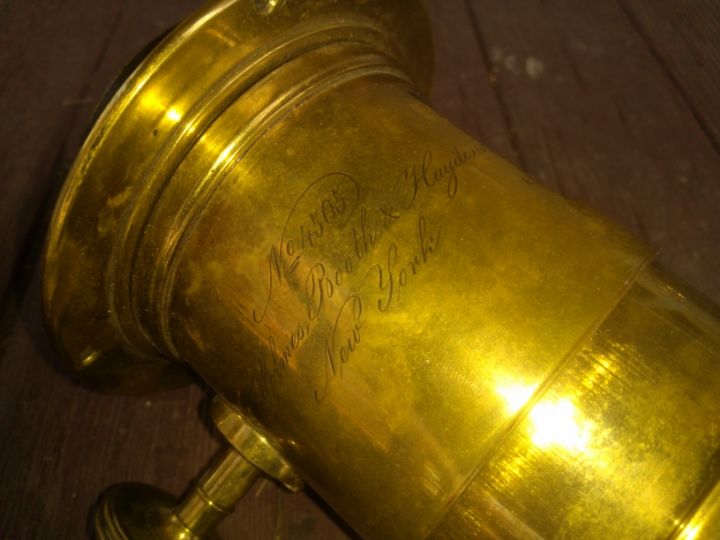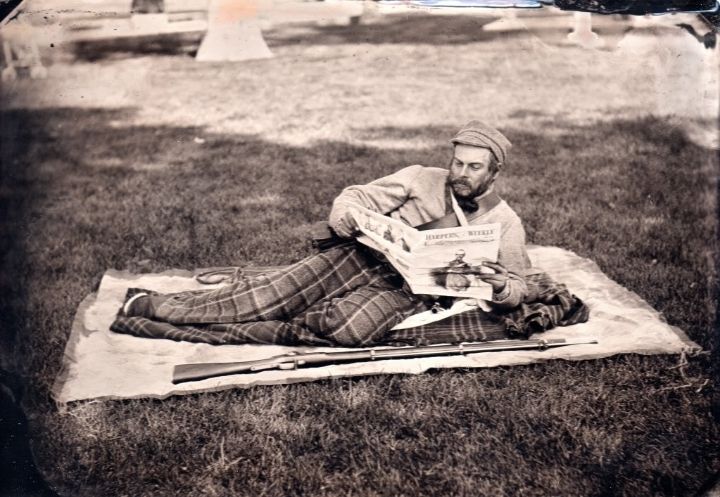19th Century Photo of Joseph Smith's "Caractors" Discovered
-
_grindael
- _Emeritus
- Posts: 6791
- Joined: Mon Aug 08, 2011 8:15 am
19th Century Photo of Joseph Smith's "Caractors" Discovered
I felt it was time to reveal this discovery that I made last year....
http://mormonitemusings.com/2013/08/26/ ... iscovered/
The details about what I've discovered about this photo will be published in four installments. Thanks.
http://mormonitemusings.com/2013/08/26/ ... iscovered/
The details about what I've discovered about this photo will be published in four installments. Thanks.
Riding on a speeding train; trapped inside a revolving door;
Lost in the riddle of a quatrain; Stuck in an elevator between floors.
One focal point in a random world can change your direction:
One step where events converge may alter your perception.
Lost in the riddle of a quatrain; Stuck in an elevator between floors.
One focal point in a random world can change your direction:
One step where events converge may alter your perception.
-
_The Erotic Apologist
- _Emeritus
- Posts: 3050
- Joined: Fri Jun 24, 2011 8:07 pm
Re: 19th Century Photo of Joseph Smith's "Caractors" Discove
Wow, thank you for posting this!
Can you tell me a little about the glass plate that bears this image?
I'm assuming the image from your blog (below) is a direct-contact print on albumin paper, but I'd like to know more about the glass negative that created the print. Is it a wet collodion ("wet plate") negative? Or is it a later, gelatin-based negative?
I'm guessing it's a wet collodion image due to the presence of artifacts that occur when the emulsion is manually decanted onto the glass. Pouring liquid collodion onto glass can be a little messy and it almost always leaves telltale artifacts. (Wet collodion was popular well into the 1870's, though there were hold-outs in the photographic trades who used wet emulsion well into the early 1900's. 95% of those old Civil War images were produced with wet collodion emulsion.)
I'm also wondering whether the negative is a first- or a second generation image. In other words, is it a copy of an even earlier image, such as a daguerreotype? It looks like a first generation image, but the fact that it's not reversed makes me think it might be a second gen image...assuming it wasn't flipped around in Photoshop.

And just for fun, here are some pics of a half-plate Petzval-style portrait lens from my collection. It was manufactured in New York, circa 1859. (The "Caractors" negative was probably made with a rapid rectilinear lens, probably manufactured by Voightlander...but that's just wild guess.)


Can you tell me a little about the glass plate that bears this image?
I'm assuming the image from your blog (below) is a direct-contact print on albumin paper, but I'd like to know more about the glass negative that created the print. Is it a wet collodion ("wet plate") negative? Or is it a later, gelatin-based negative?
I'm guessing it's a wet collodion image due to the presence of artifacts that occur when the emulsion is manually decanted onto the glass. Pouring liquid collodion onto glass can be a little messy and it almost always leaves telltale artifacts. (Wet collodion was popular well into the 1870's, though there were hold-outs in the photographic trades who used wet emulsion well into the early 1900's. 95% of those old Civil War images were produced with wet collodion emulsion.)
I'm also wondering whether the negative is a first- or a second generation image. In other words, is it a copy of an even earlier image, such as a daguerreotype? It looks like a first generation image, but the fact that it's not reversed makes me think it might be a second gen image...assuming it wasn't flipped around in Photoshop.

And just for fun, here are some pics of a half-plate Petzval-style portrait lens from my collection. It was manufactured in New York, circa 1859. (The "Caractors" negative was probably made with a rapid rectilinear lens, probably manufactured by Voightlander...but that's just wild guess.)


Surprise, surprise, there is no divine mandate for the Church to discuss and portray its history accurately.
--Yahoo Bot
I pray thee, sir, forgive me for the mess. And whether I shot first, I'll not confess.
--Han Solo, from William Shakespeare's Star Wars
--Yahoo Bot
I pray thee, sir, forgive me for the mess. And whether I shot first, I'll not confess.
--Han Solo, from William Shakespeare's Star Wars
-
_grindael
- _Emeritus
- Posts: 6791
- Joined: Mon Aug 08, 2011 8:15 am
Re: 19th Century Photo of Joseph Smith's "Caractors" Discove
Hi EA,
I can only give you the information that is on the Clay County Museum Site,
I have found out a lot of information on this document, which confirms that it is probably not the original that Martin Harris took to Charles Anthon in 1828.
I can only give you the information that is on the Clay County Museum Site,
Jacob T. Hicks was the first professional photographer in Clay and Ray Counties (Missouri). Born in Liberty, Missouri on October 6, 1840 and died in Liberty, Missouri in March of 1924. He retired in 1912.
His niece, Mrs. B.P. (Nadine Fisher) Thompson - who lived in Liberty - preserved the collection of his glass negatives from which these photographs are made. The collection includes almost 400 glass negatives of various sizes - 3 1/4" x 4 1/4", 5" x 7" and 8" x 10".
Many are historically important subjects in the area, or of early prominent individuals, while many others are presently unknown.
It is possible that Mr. Hicks used the first successful process that was actually practical in making his first photographs, the daguerreotpye, but since this used a polished plate coated with light sensitive chemicals no nagative was involved. Unless some of these are recovered this would be speculation, but since some of the early negatives are of the "wet plate" type it is known that he used the first practical method that used a negative. This used a glass plate which was coated with chemicals which were dipped in a solution just before exposure, place in the camera wet, and then exposed to make the negative from which the positive print was produced. Wet plates allowed shorter exposure times than the Daguerre process, and more than one print could be made from one photograph. His later photographs were made using the dry plate method. Because this was invented in the 1870's and available commercially in the mid 1880's, it is assumed that this could be used to date most of the photographs made prior to about 1885.
I have found out a lot of information on this document, which confirms that it is probably not the original that Martin Harris took to Charles Anthon in 1828.
Riding on a speeding train; trapped inside a revolving door;
Lost in the riddle of a quatrain; Stuck in an elevator between floors.
One focal point in a random world can change your direction:
One step where events converge may alter your perception.
Lost in the riddle of a quatrain; Stuck in an elevator between floors.
One focal point in a random world can change your direction:
One step where events converge may alter your perception.
-
_The Erotic Apologist
- _Emeritus
- Posts: 3050
- Joined: Fri Jun 24, 2011 8:07 pm
Re: 19th Century Photo of Joseph Smith's "Caractors" Discove
grindael wrote:Hi EA,
I can only give you the information that is on the Clay County Museum Site,Jacob T. Hicks was the first professional photographer in Clay and Ray Counties (Missouri). Born in Liberty, Missouri on October 6, 1840 and died in Liberty, Missouri in March of 1924. He retired in 1912.
His niece, Mrs. B.P. (Nadine Fisher) Thompson - who lived in Liberty - preserved the collection of his glass negatives from which these photographs are made. The collection includes almost 400 glass negatives of various sizes - 3 1/4" x 4 1/4", 5" x 7" and 8" x 10".
Many are historically important subjects in the area, or of early prominent individuals, while many others are presently unknown.
It is possible that Mr. Hicks used the first successful process that was actually practical in making his first photographs, the daguerreotpye, but since this used a polished plate coated with light sensitive chemicals no nagative was involved. Unless some of these are recovered this would be speculation, but since some of the early negatives are of the "wet plate" type it is known that he used the first practical method that used a negative. This used a glass plate which was coated with chemicals which were dipped in a solution just before exposure, place in the camera wet, and then exposed to make the negative from which the positive print was produced. Wet plates allowed shorter exposure times than the Daguerre process, and more than one print could be made from one photograph. His later photographs were made using the dry plate method. Because this was invented in the 1870's and available commercially in the mid 1880's, it is assumed that this could be used to date most of the photographs made prior to about 1885.
I have found out a lot of information on this document, which confirms that it is probably not the original that Martin Harris took to Charles Anthon in 1828.
That's fascinating, thanks, grindael. The more I look at the "Caractors" image, the more I'm convinced it's from an earlier wet collodion negative.
This image (below) is also from a wet collodion negative, due to the "oyster stain" on the lower right corner where the photographer held the plate between his thumb and forefinger while pouring the emulsion, and the silver-halide crust along the bottom edge where the collodion "gooped up" while the excess emulsion was being poured off the glass and back into the decanter. (I should probably stop now before I really start to geek out.)

So I'm of the opinion that both this and the "Caractors" negatives were made in the 1870's, or even earlier. I suppose it's even technically possible for the "Caractors" negative to have been made in the late 1850's.
One more thing--the top edge of the "Caractors" image looks a little bit like it's been cropped.
Again, thanks for posting this!
Surprise, surprise, there is no divine mandate for the Church to discuss and portray its history accurately.
--Yahoo Bot
I pray thee, sir, forgive me for the mess. And whether I shot first, I'll not confess.
--Han Solo, from William Shakespeare's Star Wars
--Yahoo Bot
I pray thee, sir, forgive me for the mess. And whether I shot first, I'll not confess.
--Han Solo, from William Shakespeare's Star Wars
-
_The Erotic Apologist
- _Emeritus
- Posts: 3050
- Joined: Fri Jun 24, 2011 8:07 pm
Re: 19th Century Photo of Joseph Smith's "Caractors" Discove
grindael wrote:I have found out a lot of information on this document, which confirms that it is probably not the original that Martin Harris took to Charles Anthon in 1828.
Yeah, the Mark Hofmann forgery is probably a lot closer to what the Anton Transcript actually looked like.
Of course the holy grail of early Mormon photography would be the 1844 daguerreotype likeness of 'ol Joe himself. It's probably about the size of a playing card...
Surprise, surprise, there is no divine mandate for the Church to discuss and portray its history accurately.
--Yahoo Bot
I pray thee, sir, forgive me for the mess. And whether I shot first, I'll not confess.
--Han Solo, from William Shakespeare's Star Wars
--Yahoo Bot
I pray thee, sir, forgive me for the mess. And whether I shot first, I'll not confess.
--Han Solo, from William Shakespeare's Star Wars
-
_grindael
- _Emeritus
- Posts: 6791
- Joined: Mon Aug 08, 2011 8:15 am
Re: 19th Century Photo of Joseph Smith's "Caractors" Discove
Hi EA,
Thanks for the insightful replies. There is a second image, found here http://www.flickr.com/photos/claycounty ... 435838298/ that is not as good.
Why would you date these to earlier than 1870? I thought the process wasn't developed until then? Give me reasons! I need to date these photos. I have an idea, but some technical explanations would be helpful. Is a date of 1867 reasonable, and why would it be?
Thanks a lot!
Thanks for the insightful replies. There is a second image, found here http://www.flickr.com/photos/claycounty ... 435838298/ that is not as good.
Why would you date these to earlier than 1870? I thought the process wasn't developed until then? Give me reasons! I need to date these photos. I have an idea, but some technical explanations would be helpful. Is a date of 1867 reasonable, and why would it be?
Thanks a lot!
Riding on a speeding train; trapped inside a revolving door;
Lost in the riddle of a quatrain; Stuck in an elevator between floors.
One focal point in a random world can change your direction:
One step where events converge may alter your perception.
Lost in the riddle of a quatrain; Stuck in an elevator between floors.
One focal point in a random world can change your direction:
One step where events converge may alter your perception.
-
_grindael
- _Emeritus
- Posts: 6791
- Joined: Mon Aug 08, 2011 8:15 am
Re: 19th Century Photo of Joseph Smith's "Caractors" Discove
Well, Hicks was born in 1840 so I doubt that they were made in the 1850's so we can rule that out. 
Riding on a speeding train; trapped inside a revolving door;
Lost in the riddle of a quatrain; Stuck in an elevator between floors.
One focal point in a random world can change your direction:
One step where events converge may alter your perception.
Lost in the riddle of a quatrain; Stuck in an elevator between floors.
One focal point in a random world can change your direction:
One step where events converge may alter your perception.
-
_The Erotic Apologist
- _Emeritus
- Posts: 3050
- Joined: Fri Jun 24, 2011 8:07 pm
Re: 19th Century Photo of Joseph Smith's "Caractors" Discove
grindael wrote:Hi EA,
Thanks for the insightful replies. There is a second image, found here http://www.flickr.com/photos/claycounty ... 435838298/ that is not as good.
Why would you date these to earlier than 1870? I thought the process wasn't developed until then? Give me reasons! I need to date these photos. I have an idea, but some technical explanations would be helpful. Is a date of 1867 reasonable, and why would it be?
Thanks a lot!
Well, in the late 1870's and early 1880's, most photographers were transitioning from wet collodion to dry gelatin plates. So, the fact that the "Caractors" image appears to have been printed from (at least to my eye) a wet collodion negative means it was likely exposed no later than the late-1870's.
In other words, wet collodion = most likely earlier than 1880; dry gelatin = definitely later than 1880. (But don't forget that some photographers stuck with wet collodion well past 1900.)
I apologize for not being able to be more definitive about these dates...that's just the nature of the beast. (And if things weren't already confusing enough, wet collodion photography is undergoing a modern Renaissance, with hundreds of fine art photographers cranking out thousands of contemporary wet plate images.)
Last edited by Guest on Mon Aug 26, 2013 8:03 am, edited 1 time in total.
Surprise, surprise, there is no divine mandate for the Church to discuss and portray its history accurately.
--Yahoo Bot
I pray thee, sir, forgive me for the mess. And whether I shot first, I'll not confess.
--Han Solo, from William Shakespeare's Star Wars
--Yahoo Bot
I pray thee, sir, forgive me for the mess. And whether I shot first, I'll not confess.
--Han Solo, from William Shakespeare's Star Wars
-
_The Erotic Apologist
- _Emeritus
- Posts: 3050
- Joined: Fri Jun 24, 2011 8:07 pm
Re: 19th Century Photo of Joseph Smith's "Caractors" Discove
Yes, a date of 1867 would be entirely reasonable for a wet plate negative, such as was used to make the "Caractors" print. This print shows many of the characteristics that are typical of wet collodion on glass. (Conversely, if it were a dry gelatin negative, it would have to have been exposed sometime after 1880.)
Here's another image that's a good example of the types of artifacts one looks for when trying to distinguish a wet collodion image from a dry gelatin image:

Here's another image that's a good example of the types of artifacts one looks for when trying to distinguish a wet collodion image from a dry gelatin image:

Surprise, surprise, there is no divine mandate for the Church to discuss and portray its history accurately.
--Yahoo Bot
I pray thee, sir, forgive me for the mess. And whether I shot first, I'll not confess.
--Han Solo, from William Shakespeare's Star Wars
--Yahoo Bot
I pray thee, sir, forgive me for the mess. And whether I shot first, I'll not confess.
--Han Solo, from William Shakespeare's Star Wars
-
_ludwigm
- _Emeritus
- Posts: 10158
- Joined: Thu Oct 18, 2007 8:07 am
Re: 19th Century Photo of Joseph Smith's "Caractors" Discove
The Erotic Apologist wrote:And just for fun, here are some pics of a half-plate Petzval-style portrait lens from my collection.
Just for fun...
Joseph Petzval
viewtopic.php?p=745242#p745242 (off topic thread) ... because there is Hungarian régimen ...
- Whenever a poet or preacher, chief or wizard spouts gibberish, the human race spends centuries deciphering the message. - Umberto Eco
- To assert that the earth revolves around the sun is as erroneous as to claim that Jesus was not born of a virgin. - Cardinal Bellarmine at the trial of Galilei
- To assert that the earth revolves around the sun is as erroneous as to claim that Jesus was not born of a virgin. - Cardinal Bellarmine at the trial of Galilei